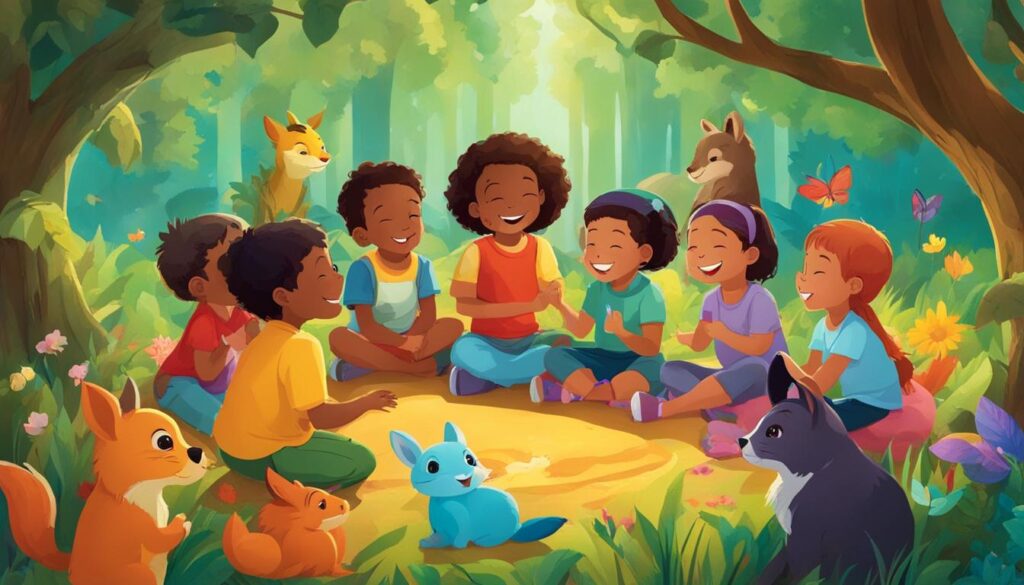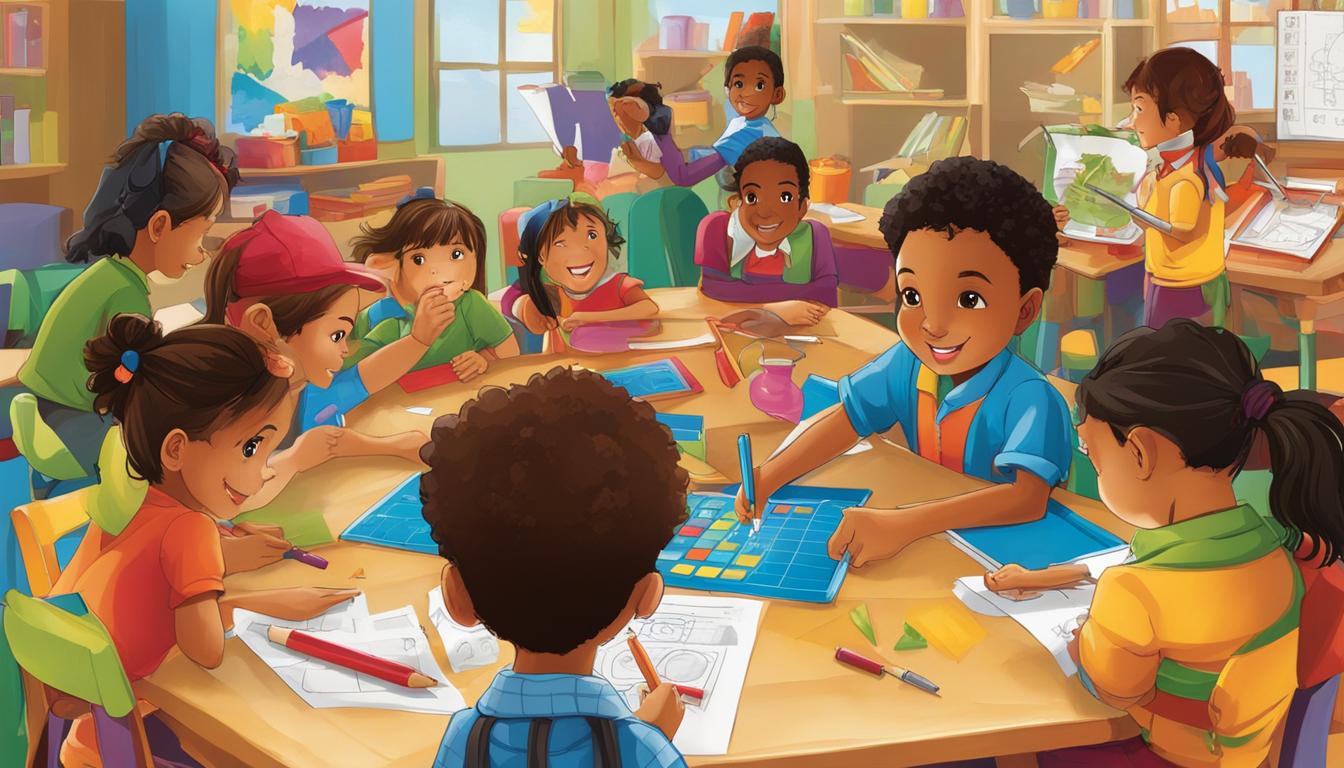Visualisation techniques for children can be a fun and effective way to enhance their learning experience. By using visual aids and pictures to help kids learn, you can ignite their imagination and promote active engagement with the material. Whether it’s in reading, math, art, music, or even personal development, visualisation has the power to unlock their potential and foster a deeper understanding of the world around them.
Key Takeaways:
- Visualisation techniques for children improve comprehension and foster active reading.
- Using visual aids and pictures to help kids learn enhances their understanding of key concepts.
- Visualisation can be applied in various subjects, such as math, art, and music education.
- Visualisation exercises for children promote creativity, imagination, and well-being.
- Visualisation is a powerful tool for setting goals, reducing anxiety, and building self-confidence.
The Power of Visualisation in Reading Comprehension
Visualisation is a transformative tool that can greatly enhance reading comprehension in children. By creating mental images while reading, children develop a deeper understanding of the text and actively engage with the story. The benefits of visualisation for kids are numerous and profound.
When children visualise while reading, they become active and alert readers, paying closer attention to details in the text. This heightened awareness helps them understand key story elements, such as characters, settings, and plot events. By visualising, children can empathise with the characters and connect with the story on a more emotional level, making the reading experience more enjoyable and meaningful.
Furthermore, visualisation improves children’s ability to recall and summarise the text. By creating mental images of the story, children create a visual map of the information, making it easier to remember and retell the story in their own words. This process also enhances their ability to make inferences, as they can draw upon their mental images to make logical connections and understand the deeper meaning of the text.
Visualising while reading also promotes self-monitoring of comprehension. Children learn to gauge their understanding of the text by checking if their mental images align with the events and details in the story. If there is a disconnect, they can identify areas where they need to reread or seek clarification. This self-monitoring skill is crucial for independent reading and lifelong learning.
The Power of Visualisation in Reading Comprehension
“Visualisation is like a movie playing in your mind. It brings the story to life and helps you understand it better.” – Sarah, 10 years old
In conclusion, visualising while reading is a highly effective strategy for improving reading comprehension in children. It encourages active and attentive reading, enhances understanding and retention of the text, and fosters critical thinking skills. By incorporating visualisation techniques into reading activities, educators and parents can help children become confident and skilled readers, setting them on a path towards lifelong success.
Table: Benefits of Visualisation for Kids
| Benefits | Description |
|---|---|
| Improved comprehension | Visualising helps children understand and interpret the text at a deeper level. |
| Enhanced engagement | Visualisation makes reading more enjoyable and meaningful for children. |
| Increased retention | Mental images created through visualisation aid in remembering and summarising the text. |
| Critical thinking skills | By visualising, children learn to make inferences and analyze the deeper meaning of the text. |
| Self-monitoring of comprehension | Visualisation helps children assess their understanding and make adjustments as needed. |
Using Visualisation to Teach Shapes and Math
Visualisation can be a powerful tool in teaching children about shapes and math. By incorporating read-alouds, visualisation techniques, and sketching, children can develop a deeper understanding of these concepts. This approach not only enhances their learning experience but also encourages strategic thinking and real-world connections.
One effective way to use visualisation in teaching shapes is through read-alouds. By reading stories that feature various shapes, children can visualise the shapes in their minds and develop a stronger grasp of their properties and characteristics. Teachers can engage students by asking questions about the shapes, encouraging them to describe what they see and imagine. This interactive process helps children make connections between the shapes they encounter in the story and the shapes they encounter in their everyday lives.
Sketching is another valuable tool for visualisation in math education. When children are encouraged to sketch shapes based on their mental images, they actively engage with the concepts and make their thinking visible. This process allows them to explore different possibilities and perspectives, fostering creativity and critical thinking. Additionally, sketching helps children transition from concrete representations of shapes to more abstract symbolic representations, preparing them for more complex mathematical concepts.
Table: Exploring Shapes through Visualisation
| Shape | Description | Real-life Examples |
|---|---|---|
| Circle | A closed curve with all points equidistant from the center. | Wheels, Plates |
| Square | A four-sided polygon with equal sides and four right angles. | Windows, Tiles |
| Triangle | A three-sided polygon with three angles. | Mountains, Signs |
| Rectangle | A four-sided polygon with opposite sides that are equal and four right angles. | Doors, Books |
Incorporating Visualisation in Art Education
Art can be a powerful tool for visualisation. By using images and creative activities, art education can enhance children’s ability to visualise and express their thoughts and ideas. When children engage in art, they are encouraged to tap into their imaginations and visually represent their mental images. This process not only strengthens their visualisation skills but also fosters their creativity and self-expression.
One effective activity is creating “artrageous” hats based on imagination. Children can use various art materials to design and construct hats that reflect their unique visions. This exercise allows them to explore their imagination, think critically about their designs, and bring their mental images to life. The process of visualising and creating these hats helps children develop their visualisation skills in a fun and engaging way.
Drawing a mental picture of a desired artwork is another activity that promotes visualisation in art education. By encouraging children to close their eyes and imagine the artwork they want to create, they can develop a clear mental image of their desired outcome. This exercise helps them plan and visualise the steps they need to take to achieve their artistic goals. It also allows them to explore different artistic techniques and experiment with their creativity.
| Activity | Description |
|---|---|
| “Artrageous” Hats | Children use various art materials to design and construct hats based on their imagination. |
| Drawing a Mental Picture | Children close their eyes and imagine the desired artwork they want to create. |
Art can be a powerful tool for visualisation. It allows children to visually express their thoughts and ideas, enhancing their ability to create mental images. By engaging in creative activities like designing “artrageous” hats and drawing mental pictures of desired artworks, children can develop their visualisation skills and unlock their artistic potential.
Integrating Art with Other Subjects
Visual arts can also be integrated with other subjects, such as literature, science, and history, to further enhance children’s learning experience. By combining visual arts with these subjects, children can create visual representations of their understanding and deepen their comprehension. For example, in a literature lesson, children can create illustrations based on the story they have read, bringing the text to life through their visual interpretations.
Furthermore, art can also be used as a platform for exploring cultural diversity and historical events. Children can learn about different art styles from various cultures and time periods, and then create their own artworks inspired by these influences. This interdisciplinary approach not only fosters creativity but also promotes critical thinking, cultural awareness, and empathy.
- Integrate visual arts with other subjects to deepen children’s comprehension and understanding.
- Use art as a platform for exploring cultural diversity and historical events.
By incorporating visualisation techniques in art education and integrating it with other subjects, educators can provide children with a holistic learning experience that nurtures their creativity, imagination, and understanding of the world around them.
Using Visualisation in Music Education
Music has the incredible power to transport us to different worlds and evoke a range of emotions. When combined with visualisation techniques, it becomes a powerful tool for engaging children’s imaginations and enhancing their understanding and appreciation of music. Guided imagery in music education allows children to “see” the music in their minds and connect with its various elements on a deeper level.
By listening to different musical pieces and picturing what they “see” in the music, children can develop a more vibrant and immersive experience. They can imagine the drama in a symphony, feel the excitement in an upbeat melody, or sense the tragedy in a melancholic piece. Visualisation in music education not only enhances active listening but also fosters an emotional connection to the music, allowing children to explore and interpret its meaning in their own unique way.
Benefits of Visualisation in Music Education
- Enhances active listening skills
- Fosters emotional connection to music
- Develops a deeper understanding of musical elements
- Promotes creative interpretation and expression
“Visualisation in music education not only enhances active listening but also fosters an emotional connection to the music, allowing children to explore and interpret its meaning in their own unique way.”
Visualisation can be incorporated into music lessons through various activities. Teachers can encourage students to close their eyes, listen to a piece of music, and imagine a story or a scene unfolding in their minds. They can then discuss their visualisations and how they relate to the music. Additionally, visual aids such as images, videos, or live demonstrations can be used to supplement the listening experience and further stimulate the imagination.
| Benefits of Visualisation | Benefits of Music Education |
|---|---|
| Enhances active listening skills | Develops cognitive abilities |
| Fosters emotional connection to music | Improves memory and concentration |
| Develops a deeper understanding of musical elements | Enhances creativity and self-expression |
| Promotes creative interpretation and expression | Builds teamwork and collaboration |
By integrating visualisation into music education, teachers can create a more immersive and engaging learning experience. It encourages students to actively participate and explore their own interpretations of music, fostering their creativity, imagination, and overall appreciation for the art form. By combining the power of music and visualisation, children can embark on a truly transformative journey of self-discovery and personal expression.
The Role of Visualisation in Well-Being
Visualisation exercises for children can contribute significantly to their overall well-being and personal development. By using visualisation techniques, children can learn to create mental images of their desired outcomes and experiences, fostering a positive mindset, motivation, and focus. Visualisation is a powerful tool that has been used for centuries to achieve goals, reduce anxiety, and build self-confidence.
Through visualisation, children can imagine themselves achieving their goals, whether it’s acing a test, scoring a winning goal, or making new friends. By vividly envisioning these accomplishments, children can develop a sense of belief in their abilities and establish a roadmap for success. Visualisation exercises can be practiced through guided meditations or by engaging children in creative activities that allow them to imagine and visualise their goals.
Visualisation involves imagining desired outcomes in vivid detail, engaging all senses.
Furthermore, visualisation exercises can also help children manage stress and anxiety. By visualising a peaceful and calming place, children can create a safe mental sanctuary during times of stress. This technique allows them to tap into their imagination, triggering relaxation responses and reducing feelings of anxiety. Visualisation exercises can be incorporated into daily routines to provide children with a tool to navigate and overcome challenging situations.
The Benefits of Visualisation Exercises for Children:
- Develop a positive mindset and motivation
- Enhance focus and attention
- Build self-confidence and belief in one’s abilities
- Reduce stress and anxiety
- Create a roadmap for success and goal achievement
Table: Benefits of Visualisation Exercises for Children
| Benefit | Description |
|---|---|
| Positive mindset and motivation | Visualisation exercises help children develop a positive mindset and enhance their motivation to achieve their goals. |
| Focus and attention | Visualisation improves focus and attention by training the mind to concentrate on specific images and goals. |
| Self-confidence | By imagining themselves accomplishing their goals, children can build self-confidence and belief in their abilities. |
| Stress and anxiety reduction | Visualisation exercises provide children with a coping mechanism to manage stress and reduce feelings of anxiety. |
| Roadmap for success | Visualisation helps children create a roadmap for success, outlining the steps and actions needed to achieve their goals. |

What Is Visualisation and Why Is It Important?
Visualisation is a powerful technique that involves creating detailed mental images of desired future outcomes. It allows individuals, including children, to set goals, focus their attention, and take deliberate action towards achieving their dreams. Visualisation is particularly beneficial for kids as it enhances their learning experience, boosts creativity, and develops important cognitive skills.
When children visualise, they engage their imagination and tap into their senses. They can see, hear, smell, taste, and feel the experiences they imagine. This multisensory approach makes learning more engaging and memorable, as it activates different areas of the brain and enhances information processing. By visualising, children can immerse themselves in a world of possibilities and explore new ideas with enthusiasm.
Visualisation enables children to think beyond the constraints of their current reality and embrace their potential. It empowers them to dream big, develop a positive mindset, and cultivate resilience in the face of challenges. Through visualisation, children learn to believe in themselves and their abilities, paving the way for personal and academic success.
Moreover, visualisation improves focus and concentration. By visualising their goals and desired outcomes, children become more motivated and committed to taking action. They develop a clearer sense of direction and purpose, which helps them overcome distractions and stay on track. Visualisation strengthens their ability to set priorities, plan effectively, and make mindful choices that align with their aspirations.
| Benefits of Visualisation for Kids | How Visualisation Enhances Learning |
|---|---|
| 1. Boosts creativity and imagination | 1. Enhances engagement and active participation |
| 2. Develops problem-solving skills | 2. Improves comprehension and information retention |
| 3. Increases motivation and self-confidence | 3. Stimulates critical thinking and analysis |
| 4. Enhances memory and information processing | 4. Fosters empathy and emotional intelligence |
| 5. Improves focus and concentration | 5. Cultivates goal setting and planning skills |
Visualisation is a tool that empowers children to shape their future and unleash their potential. By harnessing the power of their imagination, children can develop essential skills, build self-confidence, and embrace lifelong learning. Whether they are exploring new concepts, setting personal goals, or navigating challenges, visualisation is a valuable practice that supports their growth and success.
How to Practice Visualisation: 5 Steps
Practicing visualisation is a powerful way to harness the benefits of this technique. By following these five steps, you can effectively incorporate visualisation into your daily routine:
Step 1: Set Clear Goals and Desires
Begin by writing down your goals and desires in detail. Be specific and use all your senses to imagine what achieving those goals would look, feel, sound, taste, and smell like. The more vividly you can visualise your desired outcomes, the more powerful the effect will be.
Step 2: Tap into Your Emotions
As you visualise your goals, connect with the emotions associated with achieving them. Imagine the joy, excitement, and satisfaction that you would feel once you have accomplished what you desire. Emotions add depth and intensity to your visualisation practice, making it more impactful.
Step 3: Take Daily Action
Visualisation is not a stand-alone technique. It is important to take consistent daily action towards your goals. Use your visualisation practice as a source of motivation and inspiration to stay focused and committed. Take steps, no matter how small, to move closer to your desired outcomes.
Step 4: Expand Your Knowledge
Immerse yourself in learning and gathering information related to your goals. Educate yourself about the topics, skills, or areas you need to focus on to achieve what you desire. This knowledge will enhance your visualisation practice and provide you with valuable insights and strategies.
Step 5: Make Visualisation a Daily Habit
Allocate dedicated time each day to practice visualisation. Find a quiet and comfortable space, close your eyes, and imagine your desired outcomes with clarity and enthusiasm. Create a visualisation statement that encompasses your goals and read it daily to reinforce your practice.
| Step | Description |
|---|---|
| Step 1 | Set Clear Goals and Desires |
| Step 2 | Tap into Your Emotions |
| Step 3 | Take Daily Action |
| Step 4 | Expand Your Knowledge |
| Step 5 | Make Visualisation a Daily Habit |
The Science Behind Visualisation and Its Benefits
Visualisation is a powerful technique that has been studied by psychologists to understand its effectiveness. Research has shown that visualisation activates the brain’s neuroimagery and can lead to positive outcomes. It has been utilised by elite athletes, stroke victims, and performers to enhance their performance.
When you visualise, you create a clear mental image of what you want to achieve and engage all your senses in the process. This aligns your thoughts and behaviors towards your desired outcome, building self-confidence, reducing anxiety, and improving focus and selective attention. In other words, visualisation works by shaping your mindset and paving the way for success.
“Visualisation is a powerful tool that helps you unlock your potential and achieve your goals. By vividly imagining your desired outcomes, you can create a roadmap for success and build the confidence needed to overcome challenges.”
But does visualisation really work? The answer lies in understanding its underlying mechanisms. When you visualise, your brain activates the same neural pathways as when you physically perform the action. This enhances your neural connections and strengthens the belief that you can achieve your goals. Visualisation also helps you develop mental rehearsal skills, where you practice important actions and scenarios in your mind, preparing yourself for success in the real world.
The Benefits of Visualisation
Visualisation offers a range of benefits across various aspects of life. It can help you improve performance in sports and other physical activities by enhancing muscle memory and boosting confidence. It can also aid in reducing stress and anxiety, as the act of visualising positive outcomes can trigger relaxation responses in the body.
In addition, visualisation is an effective tool for goal setting and motivation. By visualising your goals as already accomplished, you create a sense of urgency and a clear vision of what you want to achieve. This fuels your motivation and drive, leading you to take the necessary actions to turn your vision into reality.
| Benefits of Visualisation | Examples |
|---|---|
| Enhanced performance | Improved sports performance, increased confidence in public speaking |
| Stress reduction | Reduced anxiety before exams, improved relaxation |
| Goal setting and motivation | Increased focus and determination, clarity in career aspirations |
So, the next time you doubt the power of visualisation, remember that it is backed by scientific research and has been used by successful individuals across various fields. By harnessing the potential of visualisation, you can tap into your inner strength and create a positive mindset that propels you towards your goals.
Tools and Techniques for Visualisation Practice
Visualisation practice can be greatly enhanced with the use of various tools and techniques. These tools help individuals clarify their values, desires, and goals, and imagine their desired future states with greater clarity and motivation.
Vision Board
One popular tool for visualisation practice is a vision board. A vision board is a collage of images, words, and phrases that represent your goals and desires. It serves as a visual reminder and inspiration for what you want to achieve. You can create a vision board by cutting out pictures from magazines, printing images from the internet, or even using handwritten words and drawings. Place your vision board in a prominent place where you can see it every day, allowing it to continually reinforce your visualisations.
Visualisation Statements
Another effective technique is the use of visualisation statements. These are written statements that describe your desired outcome in detail, using all your senses. For example, if your goal is to become a successful musician, your visualisation statement may include vivid descriptions of performing on stage, the sound of the audience clapping, the feeling of the spotlight on you, and the taste of success. Read your visualisation statement daily, ideally before or after your visualisation practice, to reinforce the image in your mind and strengthen your belief in achieving your goal.
Reflective Writing Prompts
Reflective writing prompts can also be helpful in visualisation practice. These prompts encourage you to explore your thoughts and feelings about your goals and desires through writing. By writing about your visualisations, you can gain deeper insights and create a stronger connection to your desired outcomes. Reflective writing prompts can be simple questions, such as “What does success look like to you?” or “How would achieving your goal make you feel?”. Take time to reflect on these prompts and write down your thoughts and emotions, allowing your visualisation practice to become more immersive and impactful.
| Tool/Technique | Description |
|---|---|
| Vision Board | A collage of images, words, and phrases representing goals and desires. |
| Visualisation Statements | Written statements describing desired outcomes in vivid detail, using all senses. |
| Reflective Writing Prompts | Writing prompts that encourage exploration of thoughts and feelings about goals and desires. |
By incorporating these tools and techniques into your visualisation practice, you can enhance the effectiveness and impact of your visualisations. Whether it’s creating a vision board, reading visualisation statements, or engaging in reflective writing, these practices help you clarify your goals, strengthen your belief in achieving them, and create a positive mindset to support your journey towards success.
The Importance of Pre-Work in Visualisation
Before you embark on your visualisation practice, it’s crucial to lay the groundwork with some pre-work activities. These steps will help you align your desires, clarify your values, and foster a positive mindset. By taking the time to engage in these essential preparations, you can enhance the effectiveness of your visualisation practice and increase your chances of success.
Start by assessing your satisfaction levels in different areas of your life. Reflect on what is working well and what areas may need improvement. This self-reflection will provide you with valuable insights and help you identify the areas you want to focus your visualisation practice on.
Next, clarify your personal values. Take some time to contemplate what truly matters to you and what you want to prioritise in your life. By aligning your visualisations with your core values, you can create a powerful and meaningful vision for your future.
In addition, engaging in positive thinking exercises can help you cultivate a positive mindset, which is essential for effective visualisation. Practice affirmations, gratitude exercises, or journaling about positive experiences to shift your mindset towards optimism and possibility.
By investing time and effort in pre-work activities, you lay a solid foundation for your visualisation practice. These activities provide clarity, focus, and motivation, allowing you to visualise what you want with greater precision and intention. Now that you’ve done the pre-work, you’re ready to dive into the exciting world of visualisation and harness its transformative power.
| Pre-Work Steps for Effective Visualisation |
|---|
| Assess satisfaction levels in different areas of life |
| Clarify personal values |
| Engage in positive thinking exercises |
Conclusion
Visualisation is a powerful tool that can have a significant impact on a child’s learning and personal growth journey. By incorporating visualisation techniques into their daily lives, children can enhance their reading comprehension, mathematical understanding, artistic expression, and overall well-being.
Through visualisation, children develop stronger mental imagery skills, allowing them to create vivid images and immerse themselves in books, stories, and concepts. This active engagement improves focus and attention, enabling children to grasp key details, empathise with characters, and make connections.
Moreover, visualisation fosters creativity and imagination, empowering children to express their thoughts and ideas through art and music. By visually representing their imagination, children develop a deeper understanding of themselves and the world around them.
Lastly, visualisation is not limited to academic subjects but can also be used for personal growth and goal achievement. By visualising desired outcomes in detail, children can develop a positive mindset, build self-confidence, and stay motivated on their path to success.
FAQ
What is visualisation?
Visualisation is the practice of imagining desired future outcomes in vivid detail, using all five senses.
How can visualisation benefit children?
Visualisation helps children become active and alert readers, understand key story elements, recall and summarise text, and develop a positive mindset, motivation, and focus.
How can visualisation be used in math education?
Visualisation can be used to help children learn and understand shapes more effectively and make real-world math connections.
How can art be incorporated into visualisation?
Art activities, such as creating imaginative hats or drawing desired artworks, can enhance children’s ability to visualise and express their thoughts and ideas.
How can music be combined with visualisation?
By listening to music and picturing what they “see” in the music, children can enhance their understanding and emotional connection to different musical elements.
How can visualisation be used for overall well-being?
Visualisation techniques can help children achieve their goals, reduce anxiety, and build self-confidence by imagining desired outcomes in vivid detail.
How can individuals practice visualisation effectively?
Individuals can practice visualisation by writing in detail about their desired outcomes, imagining the associated emotions, taking daily action, expanding knowledge, and making time for regular visualisation practice.
Is there scientific evidence supporting the effectiveness of visualisation?
Research has shown that visualisation activates the brain’s neuroimagery and can lead to positive outcomes in various areas of life.
What tools and techniques can enhance visualisation practice?
Tools such as vision boards, reading visualisation statements daily, and engaging in reflective writing prompts can enhance visualisation practice.
What should individuals do before starting visualisation practice?
It is important to do pre-work, such as assessing satisfaction levels, clarifying personal values, and engaging in positive thinking exercises, to lay the foundation for effective visualisation.
How can visualisation empower children?
Visualisation empowers children to become active learners, improve their mental imagery skills, and unlock their creative potential.
What is the conclusion about visualisation?
Visualisation is a powerful tool for children to enhance their learning, personal growth, and overall well-being.





4 responses to “Discovering Visualisation Techniques for Kids: Fun Learning Tools”
[…] bring my creative ideas to life and hindered my ability to imagine new possibilities. But then, I discovered a technique called Image Streaming, and everything […]
[…] I am learning to balance responsibilities and fun. […]
[…] techniques can be a fun and effective way to engage children in positive thinking and develop their imagination. By […]
[…] unique cognitive style while also cultivating skills to overcome any limitations. This may include learning techniques to enhance other senses or employing memory strategies that rely on associations or emotional […]